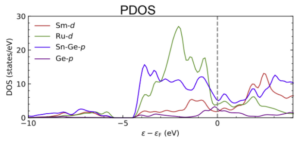Week 10: The Inevitable Conclusion
Aryan R -
Introduction
Hello my dear readers,
This week’s post will hopefully be the last week of simply producing more graphs and then analyzing them. From next week, I can go onto tying all of the results together to create a more comprehensive and useful picture that can be used in the future in further researching the materials.
The Graph

Looking Into It
Here, Ge-p peaks at eV = 0, suggesting that it significantly contributes to the Fermi Level and induces metallization into the system, increasing carrier mobility. This is the reason that the band structure of Sm3Ru4Sn11Ge2 has a reduced band gap and is more crowded than the Sn13. Overall, the ZT coefficient goes down due to an excess of electrical conductivity. For those who don’t know, the ZT coefficient is just a measure of thermoelectric efficiency. The higher it is, the better thermoelectrically a material acts.
We can see that the Ge dominates at the Fermi Level, suggesting that it, despite having a minimal impact in the system in terms of material added, has a large impact in how the material acts. Despite the indication that these materials are inefficient thermoelectrics, the presence of dense d-orbitals suggests their true electronic properties are much greater than indicated, while also contributing to their magnetic properties, something not able to be measured through these DFT calculations.
Next Week
I’m going to be discussing what all of this means and how this can best be further researched while understanding and focusing on the potential limitations using the methods I employed. Look forward to that, and see you all next time!!!

Comments:
All viewpoints are welcome but profane, threatening, disrespectful, or harassing comments will not be tolerated and are subject to moderation up to, and including, full deletion.